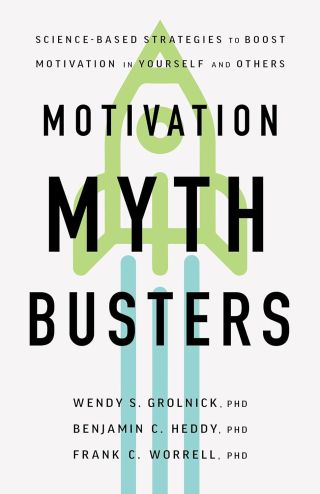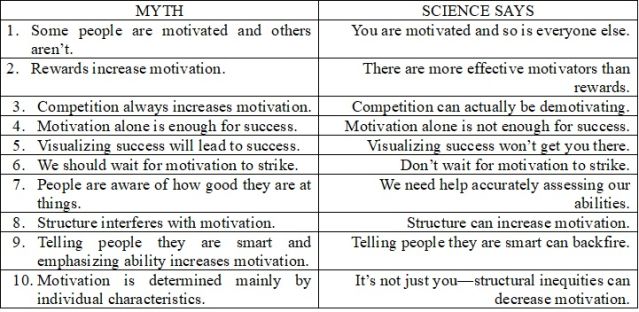Motivation
10 Motivation Myths You Probably Believe Are True
How research from educational psychology can bust motivation myths.
Posted July 29, 2024 Reviewed by Michelle Quirk
Key points
- Motivation is the energy we bring to activities as well as the direction in which we focus that energy.
- When we feel interested in an activity or feel it is important, we are more likely to persist.
- Believing in myths about motivation can lead to behaviors or strategies that hinder progress.
There are still people who believe that the Earth is flat, today, in 2024. The field of education, for example, is filled with all kinds of non-science-backed ideas, like learning styles. Invalid personality tests like the Enneagram have become popular, whereas the scientifically backed Big 5 Personality Inventory is often not even known by the general public. In the field of educational psychology, there is also a substantial literature on motivation, and a recent book titled Motivation Myth Busters: Science-Based Strategies to Boost Motivation in Yourself and Others by Wendy Grolnick, Benjamin Heddy, and Frank Worrell seeks to educate the broader public about the common myths about motivation and about what is known about motivation from decades of research in psychology. Here the authors answer questions about their new book.
What is your definition of motivation, and how can research from educational psychology be useful to the average person?

Motivation is the energy we bring to activities as well as the direction in which we focus that energy. Importantly, motives are located within people and involve the internal processes that fuel action. Motivation comes about as people try to fulfill their needs to be autonomous, or to feel choiceful about their activity, to feel competent or effective, and to feel connected with important others. With this definition, we can think about differences in the way we try to get people to act. On the one hand, we can persuade them, or we can coerce them using pressure or incentives such as rewards or punishments. However, when we attempt to facilitate motivation, we try to tap into their needs, values, and interests so that they perceive their actions as coming from within and as personally endorsed.
Thinking about motivation in this way is useful to people as they consider their own behavior as well as how they can help motivate others. For example, with regard to our own behavior, we can reflect on why we are doing an activity—is it something we find interesting or important, or is it something that someone else is pushing us to do? When we feel interested in an activity or feel it is important for our own goals and values, we are most likely to persist and be successful. With regard to helping others be motivated, we can find out about their interests, their perspective on the activity, and what they value. Then we can work with them to try to figure out how to connect the activity to their values or interests and problem-solve about what may be getting in the way of feeling motivated. Research on motivation has identified many strategies to help people channel their own and others’ motivation in ways that make for the most success, well-being, and positive relationships.
Why do “myths” about motivation matter? What are these 10 myths you discuss in your book?
Motivation is important in every aspect of our lives, from the classroom to the boardroom and office to the athletic arena or performing stage. Moreover, motivation is complicated, which is reflected in the fact that there are multiple motivation theories that speak to different aspects of motivation. Although motivation is not the only predictor of successful goal attainment, motivation can play a key role in helping individuals and groups reach important goals. Myths about motivation matter as believing in these myths can lead to engaging in behaviors or using strategies that hinder progress rather than supporting success.
Given the importance of motivation, having beliefs about it that are not accurate can interfere with reaching our goals or helping others to reach theirs. In our book, Motivation Myth Busters, we identify 10 key myths about motivation. Five of the 10 myths that we discuss were endorsed by two-thirds of a sample of 495 individuals. Even the least-endorsed myth, which was endorsed by only 8.9 percent of the sample, extrapolates outward to more than 27 million people in the United States.
Below is a list of the myths, followed by the actuality from a scientific point of view:

Why are myths so hard to change?
Belief in myths and misinformation can be especially resistant to change. There are many reasons that myths are resistant to modification including the fact that change is difficult. The strength of commitment to myths and social causes can also make myths hard to change.
First, as the saying goes, change is hard! And this statement couldn’t be truer for changing beliefs in myths. When we are faced with new information, substantial effort is required to change our knowledge. To change our beliefs, we have to try to learn the new information and integrate it into our existing framework of knowledge. Maintaining our current knowledge is far easier as it requires much less effort. Therefore, unless there is a good reason for us to change our beliefs, the path of least resistance is to ignore the new information. In the case of belief change, ignorance is truly bliss.
Second, people are often deeply committed to their beliefs. When new information conflicts with worldviews, changing beliefs can be stifled. This is especially the case when information is misaligned with politically or religiously charged beliefs. For example, climate change is a politically charged topic, and this is why widespread acceptance of this scientifically accepted construct is difficult to establish. Strength of commitment to beliefs is a major factor for predicting likelihood of change in myth belief.
Third, and finally, our social circles can be influential in determining whether we change our beliefs in myths. That is, if our social circle strongly believes in a myth, we are likely to also believe it and to resist changing that belief. As an example, there is a small but growing number of people who believe that the Earth is flat. Flat Earthers continuously run experiments to try to disprove the spherical view of our world. However, their experiments often fall flat (pun intended) and prove the exact opposite, that the Earth is, in fact, round. However, changing their belief in the myth of a flat Earth would also mean losing their sense of belonging to their social circle of believers. As a result, they resist change, even in the face of evidence that counters their belief.
Myths are prevalent in our society for a reason. They are resistant to change and, therefore, they stick around. Myths about motivation are no different, especially with the amount of misinformation that can be easily accessed online. However, our book, Motivation Myth Busters, uses cutting-edge, evidence-based strategies to help people change their beliefs and better motivate themselves and others.
References
Grolnick, W. S., Heddy, B. C., & Worrell, F. C. (2024). Motivation Myth Busters: Science-Based Strategies to Boost Motivation in Yourself and Others. American Psychological Association.




